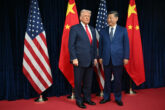October 29, 2018
How to tell if North Korea is serious about denuclearization
Since the Singapore summit between US President Donald Trump and North Korean leader Kim Jong-un in June, Pyongyang has made gestures and statements suggesting that it will curtail its nuclear-missile programs. However, in the absence of a nuclear deal between Washington and Pyongyang, the North’s nuclear arsenal continues to expand, and the regime continues to violate UN Security Council Resolutions that prohibit nuclear and missile-related activities.
With preparations for a second Trump-Kim summit underway, how should the international community determine what initial denuclearization steps really count? As Washington and Seoul engage with North Korea diplomatically, they have a rare opportunity to persuade the regime that surrendering its nuclear weapons and programs will in fact lead to a brighter future and eventual peace on the Korean Peninsula. But observers need to distinguish steps that are symbolic at best from those that demonstrate Pyongyang’s seriousness. Grabbing hold of whatever Pyongyang offers indiscriminately will only weaken Washington’s future negotiating position.
Before deciding what does constitute a meaningful or serious offer from North Korea, it is helpful to consider what does not. The broad targets of North Korea’s denuclearization should include: the regime’s fissile and thermonuclear material production programs, its nuclear weaponization program, its nuclear weapons and related missiles and other delivery systems, its proliferation programs, and its illicit trade and smuggling networks. Each element is comprised of various facilities, materials, and technologies. With that level of complexity, North Korea could divide each target into multiple steps to offer as bargaining chips, a tactic known as “salami slicing.” And while some initial steps in isolation may be noteworthy or even meaningful, they could actually become relatively meaningless depending on the context.
Read the full article in the Bulletin of the Atomic Scientists.
More from CNAS
-
North Korea Reveals Troop Dispatch to Russia amid U.S.-South Korea Policy Talks
North Korea has confirmed for the first time that its troops are operating in Russia, and it is preparing to rewrite its party charter with the possibility of officially namin...
By Dr. Go Myong-Hyun
-
Chinese Maker of Bitcoin-Mining Machines Is a Security Threat, Says Expert
Bloomberg News reports that a Chinese manufacturer, Bitmain Technologies Ltd, that sells most of the world’s Bitcoin-mining machines — including 16,000 of them to a venture ba...
By David Feith
-
Indo-Pacific Security / Energy, Economics & Security
North Korea’s Provocations, Power Plays, and Shifting AlliancesTensions on the Korean Peninsula have reached a new and dangerous threshold. President Lee Jae Myung is warning of a real risk of accidental military clashes, as the situation...
By Dr. Go Myong-Hyun
-
Indo-Pacific Security / Energy, Economics & Security
How to Win the Economic War with ChinaTrump's approach to China has run aground, giving Beijing unprecedented advantage in the economic conflict....
By Edward Fishman & Julian Gewirtz



